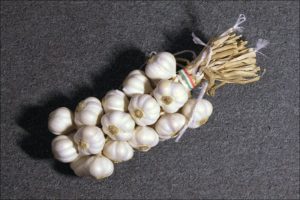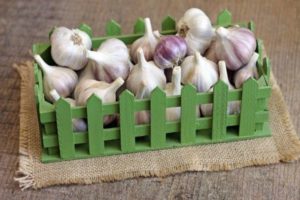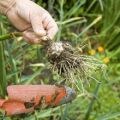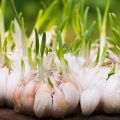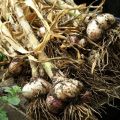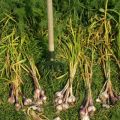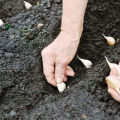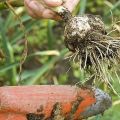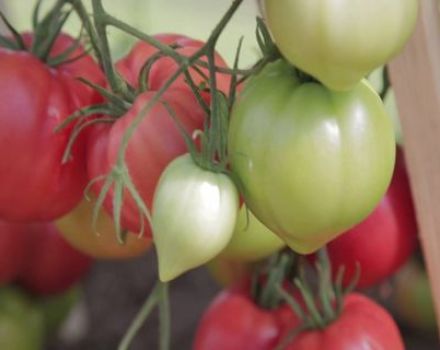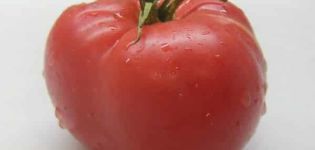Planting, growing and caring for spring garlic in the open field, whether it is necessary to tie and when
There are two types of garlic: spring and winter. Each of them has individual differences. For winter crops, the characteristic loss of juiciness and useful properties over time, and spring garlic does not change that way. That is why many summer residents prefer this variety and ask themselves the question: how to grow large summer garlic?
Spring or winter garlic?
Winter garlic is planted in late autumn, and in spring, on its last dates, the harvest is harvested. Growing a garlic culture does not cause any difficulties, while it gives high yields. For winter varieties that are planted in the winter, loss of juiciness is characteristic. This culture ripens by summer, at the moment when housewives begin to actively make preparations. By the autumn period, winter garlic dries up.
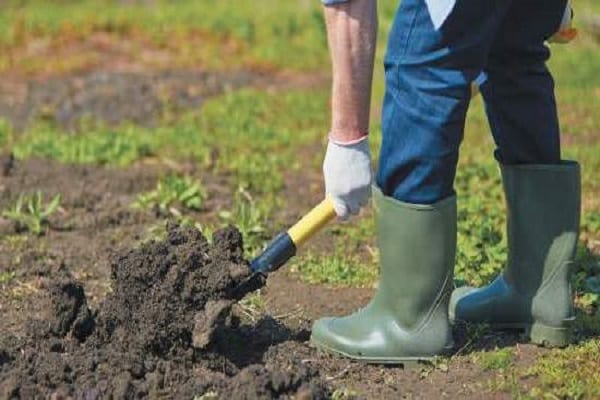
Summer residents plant spring garlic in the spring, namely in its initial period. These varieties do not have large yields, but are characterized by long keeping quality. Useful qualities and characteristics of spring crops are preserved for 12 months.
There are a number of differences between winter crops and spring crops. Winter crops are characterized by:
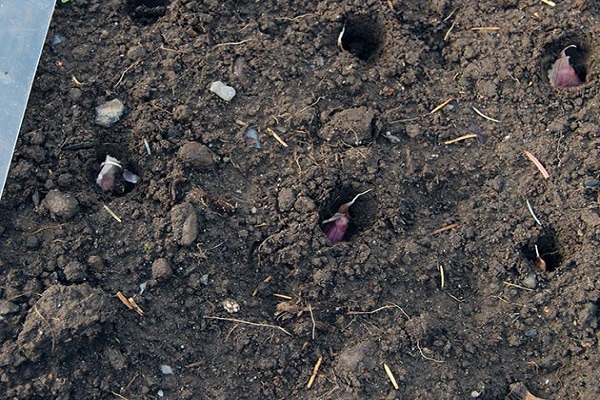
- the presence of no more than 10 cloves in the bulb;
- the release of an arrow with air bulbs necessary for reproduction;
- lobules are located in 1 row;
- propagated by air seeds;
- short shelf life.
Spring varieties differ in that:
- the bulb can have up to 30 lobules;
- they do not have arrows, the exception is the Gulliver variety;
- the teeth are arranged in a spiral, while in the central part the dimensions are reduced;
- they reproduce by teeth;
- they have a long shelf life.
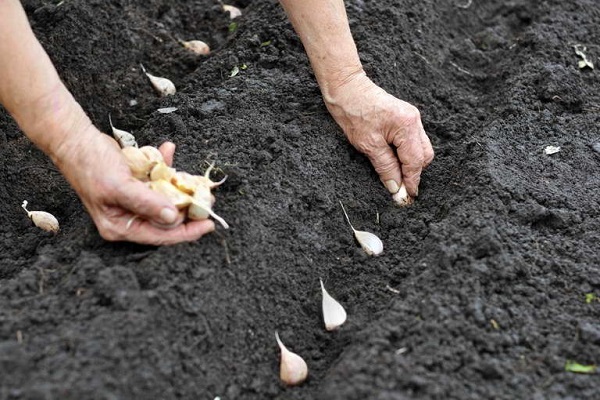
With timely planting and proper care, summer garlic is stored until the next harvest.
Boarding time
To get a good harvest of spring garlic, it must be planted in the ground on time. In order for the culture to be able to develop a full-fledged bulb during the summer period, it should be planted in early spring. These varieties are characterized by good frost resistance, so they can be planted without fear of spring frosts. The optimal time for planting is the period when the temperature of the soil reaches 5 degrees Celsius.
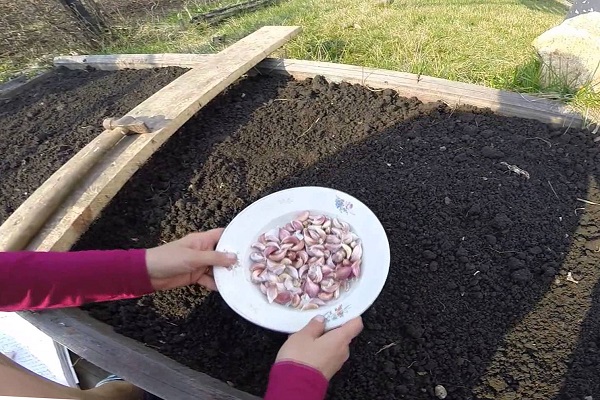
The need for early planting of a crop is due to the fact that the plant perfectly develops the root system only at low temperature and humidity. In the same period, leaves begin to actively form.
If planting is delayed, the amount of yield will be drastically reduced, since at elevated temperatures, the root system and leaves slow down their formation due to the development of the bulb. Summer residents deduced a pattern that the better the leaves and root system are formed before the temperature rises, the larger the bulbs will be. That is why outdoor cultivation of spring garlic requires adherence to planting dates.

Site preparation for planting
Before you ask the question: when to plant spring garlic in open ground, you need to know how to prepare a planting site. This is necessary in order for the culture to form full-fledged bulbs. To do this, it is recommended to know a few nuances:
- the top layer of the earth is very important for the plant, since its roots are shallow;
- the soil should have a neutral acidity level;
- the soil should be enriched with loams and humus;
- in order for the crop to be rich, lighted areas should be chosen as a planting site that protect the crop from the wind;
- if the summer cottage is in wet areas, the beds should be formed high;
- if garlic was previously grown in this place, it should be kept for 5 years until the next planting.

Before planting summer garlic, the place should be prepared in the fall. The first step is to dig up the ground, add humus or compost to it. It is also recommended to add ash, complex mineral fertilizers. The best proportions are considered to be the introduction of 10 grams of the composition per 1 square meter.
How to plant spring garlic?
Planting and caring for spring garlic requires compliance with several rules. After the onset of spring, the soil prepared in advance is loosened, the soil is moistened, and then the cloves are placed in it. If the ground is moist enough, you shouldn't add extra water, as garlic doesn't like it. When the soil is too wet, planting should be postponed until it has acquired the required consistency. If you do not follow this rule, garlic planted in moist soil will be susceptible to damage by putrefactive pathologies.
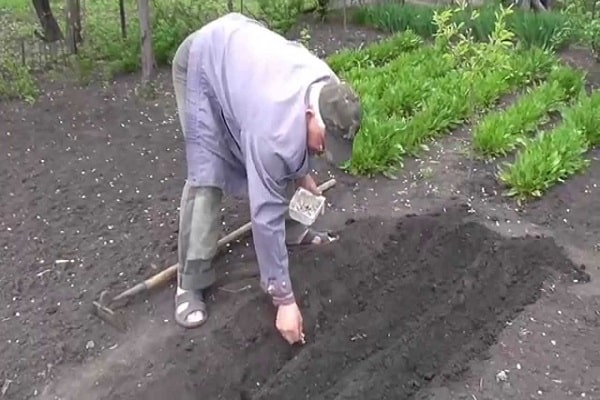
Also, some nuances must be observed when transplanting planting material into the ground:
- Between the crops, it is imperative to leave sufficient space for the development of the root system, to ensure nutrition: a gap of 25-30 centimeters should be observed between the beds, and 8 between the cloves.
- The cloves should be positioned so that their upper part does not deepen by more than 20 millimeters, otherwise the development of the bulbs may be delayed.
- After planting, the breasts are mulched with a peat composition, straw and hay, which prevent the formation of a crust, the appearance of weeds, retains moisture, and also such processing allows less often to loosen the soil.
Planting spring garlic outdoors is required by sorting small and large cloves. This approach to planting simplifies harvesting, plant care. Also, many summer residents recommend planting large slices separately for bulbs, and small ones for greenery.
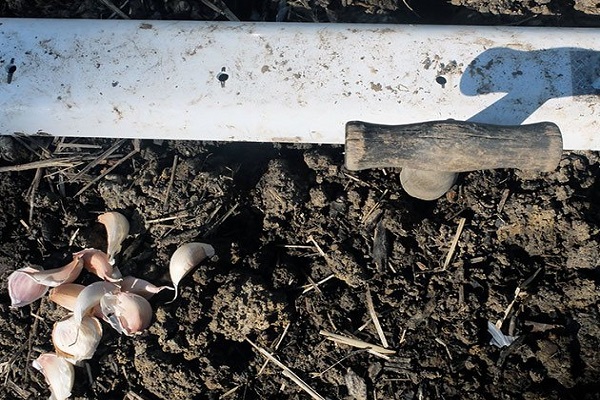
Preparation of planting material
To prepare garlic for planting, you need to pay attention to its storage method. If the blanks were stored at room temperature, then the plant culture will have a long growing season, but the bulbs will be round, large, but not fully ripe.
If the cloves have been cold stored, the growing season will be shorter and ripen quickly. This will keep the size of the bulbs small.
In order to obtain a high yield, garlic is grown using planting material stored in both ways. To do this, it is recommended to follow the instructions:
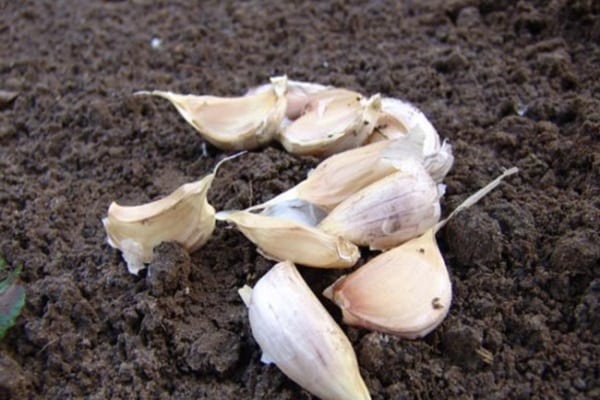
- If the garlic has been stored at room temperature, refrigerate it in the refrigerator 2 months before planting. It is worth considering that the larger the head, the longer it should lie in the cold.
- The bulbs are taken apart before planting at a time when the lower part has not yet had time to dry.
- Only coarse and solid material is selected for sowing. For this, it is recommended to use only the best large varieties: such material will allow you to get a high yield.
- The slices are cleaned of excess husk.
To increase yields, it is recommended to use growth stimulants.

Stimulating the growth of seed
Growing spring garlic sometimes requires the use of growth promoters for the seed. These preparations accelerate the maturation of the bulbs, increase the yield, and also affect the active growth of roots on the cloves. To stimulate the growth of teeth, you must follow the step-by-step recommendations:
- The cloves are placed in water or a weak manganese solution for 2-3 hours.
- The material is wrapped in a damp cloth and then placed in cellophane and a refrigerator for 2-3 days. At this time, roots will begin to form and grow.
- The resulting material tolerates planting in the ground well if it has been carefully removed from cellophane and fabric.
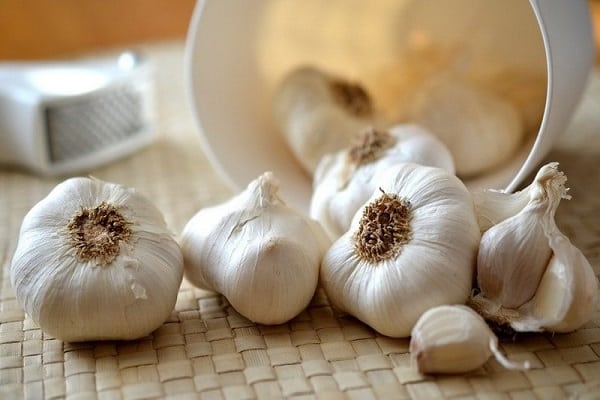
There is another way to stimulate the growth of teeth. Before planting, the teeth can be fertilized. The material is soaked in a lukewarm solution made from 10 liters of water and 5 grams of Nitroammofoska. After using such watering and fertilizers, the cloves can be immediately planted in the ground.
Care
There are several rules for caring for spring garlic that must be followed if you want to get a rich harvest. Before the onset of July, the plant culture needs moisture, since at this moment the leaves grow. If there is not enough moisture, the leaves will begin to dry from the edges. Water the plant if this symptom appears.
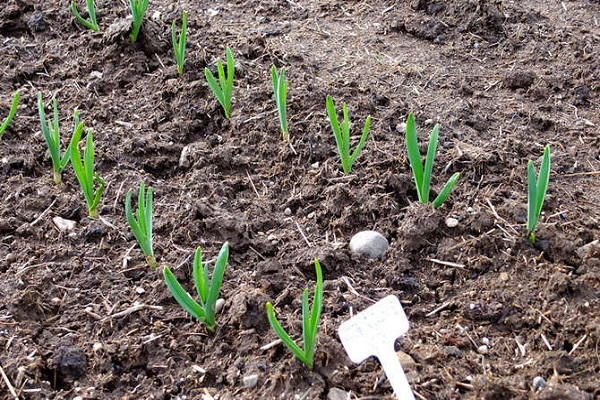
In August, summer garlic needs to be watered less, as the bulb begins to form. Gradually, watering stops completely. This is due to the fact that excess moisture will slow down the ripening of the bulbs, reduce the amount of nutrients accumulating in them. Also, excess moisture will affect the shelf life of the crop, significantly reducing it.
The soil should be loosened regularly to provide oxygen to the crop. There are no other guidelines for planting care. But many summer residents claim that fed summer garlic gives a greater harvest. Therefore, at different stages of plant development, it is recommended to make top dressing.

Does the culture need feeding?
Feeding spring garlic is required taking into account the information:
- nitrogenous fertilizers are applied during the formation of leaves on a crop; for feeding, it is suitable: a warm solution of bird droppings, herbal infusions, mullein, mineral mixtures;
- during the period of leaf formation in the absence of the necessary fertilizers in the beds, you can simply distribute humus;
- 2 weeks after the first feeding, fertilization is carried out with a liquid complex composition: during this period, shooting of spring garlic begins;
- during the period of active ripening of the bulbs, fertilization is not necessary.

All fertilization should be done with watering. It is forbidden to use fresh manure as fertilizer, since it can cause the development of crop diseases, reduce the keeping rate of the crop.
The nuances of getting a good harvest
In order for the summer resident to be satisfied with the harvest he has received, he should know about several subtleties that allow achieving such indicators. One of the most important factors in increasing yields is choosing the right garlic variety. This is due to the fact that the formation of bulbs requires a temperature in excess of 21 degrees, and for ripening - 25.In some regions, such ambient temperatures are rare, so you should immediately select varieties that ripen at lower temperatures. Also, under such conditions, it is required to use a fertilizer that stimulates growth.
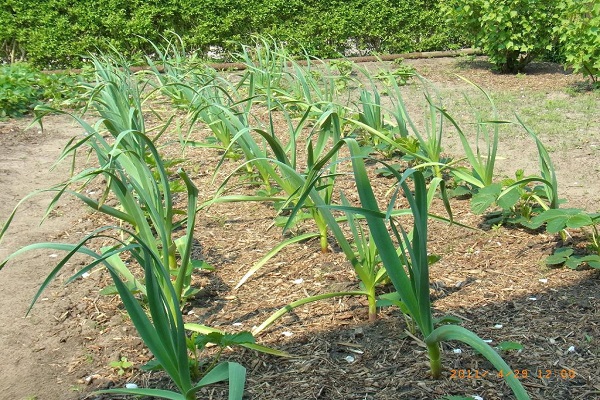
If the heat in the region does not last long, it is possible to activate the ripening process of the culture if in mid-August the bulbs are slightly removed from the soil or some of the roots are cut. Such manipulation will provoke a violation of the function of the roots, slow down growth, the culture will direct all its forces to the formation and maturation of the bulb. To speed up ripening, garlic leaves can be tied in knots.
When do you need to knit arrows of garlic in a knot? This manipulation with spring garlic is recommended in mid-August.
Many summer residents say: I renew the garlic every year. This means that the bulbs of the new crop should be used for planting next year. In this case, they should be planted in a different place. You can return to the previous garden bed in 5 years.

Harvesting garlic
With proper planting in open ground and care for spring garlic, harvesting will be possible until mid-September. The signal about the possibility of starting cleaning is the drying of the lower leaves, their acquisition of a yellow tint.
To increase the term storage of spring garlic, after harvesting, the bulbs must be left in the garden, and then transferred to dry under a canopy or left in the attic. The heads dry in bags or on a horizontal surface. Tying the garlic into bundles is also allowed.
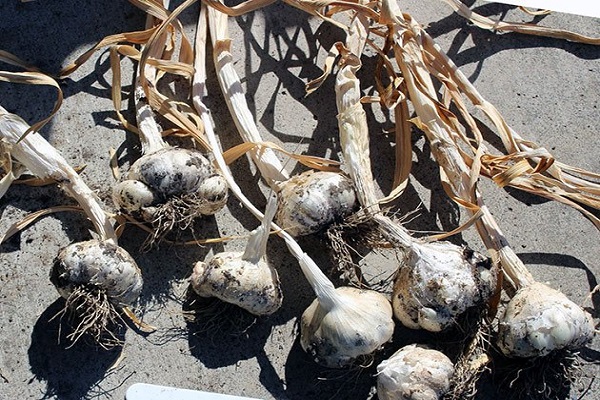
The harvested crop should be stored in a dry, cool room or in a refrigerator or basement. It is absolutely impossible to keep it under the open sun, as this will significantly reduce the shelf life of garlic.
Pests and diseases
There are several diseases that can affect a planted crop under certain environmental conditions. So, high humidity, lack of crop rotation, improper storage of crops can cause the development of:
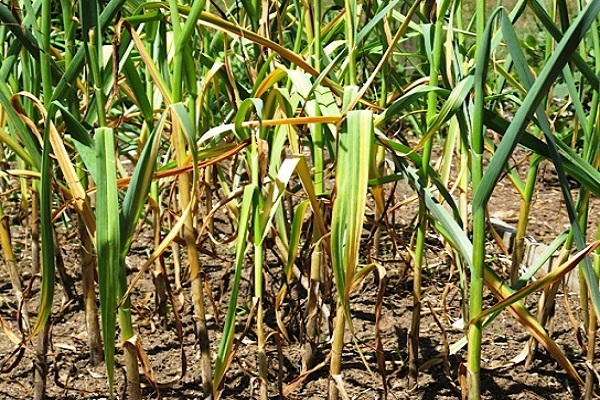
- rust;
- mold;
- bacterial rot;
- fusarium.
It is possible to recognize the presence of pathologies by the general symptomatology, which consists in the drying of the leaves, the appearance of spots on them, rotting of the foliage and bulbs, the too light color of the garlic scales.
Of the pests, the garlic culture is most often affected by onion fly larvae and nematodes. In August, spring garlic needs special care, since it is during this period that pests attack it. In the greenhouse, diseases and pests most often appear due to the lack of ventilation, high humidity, therefore, every summer resident must timely prevent the appearance of pathologies and treat them.

